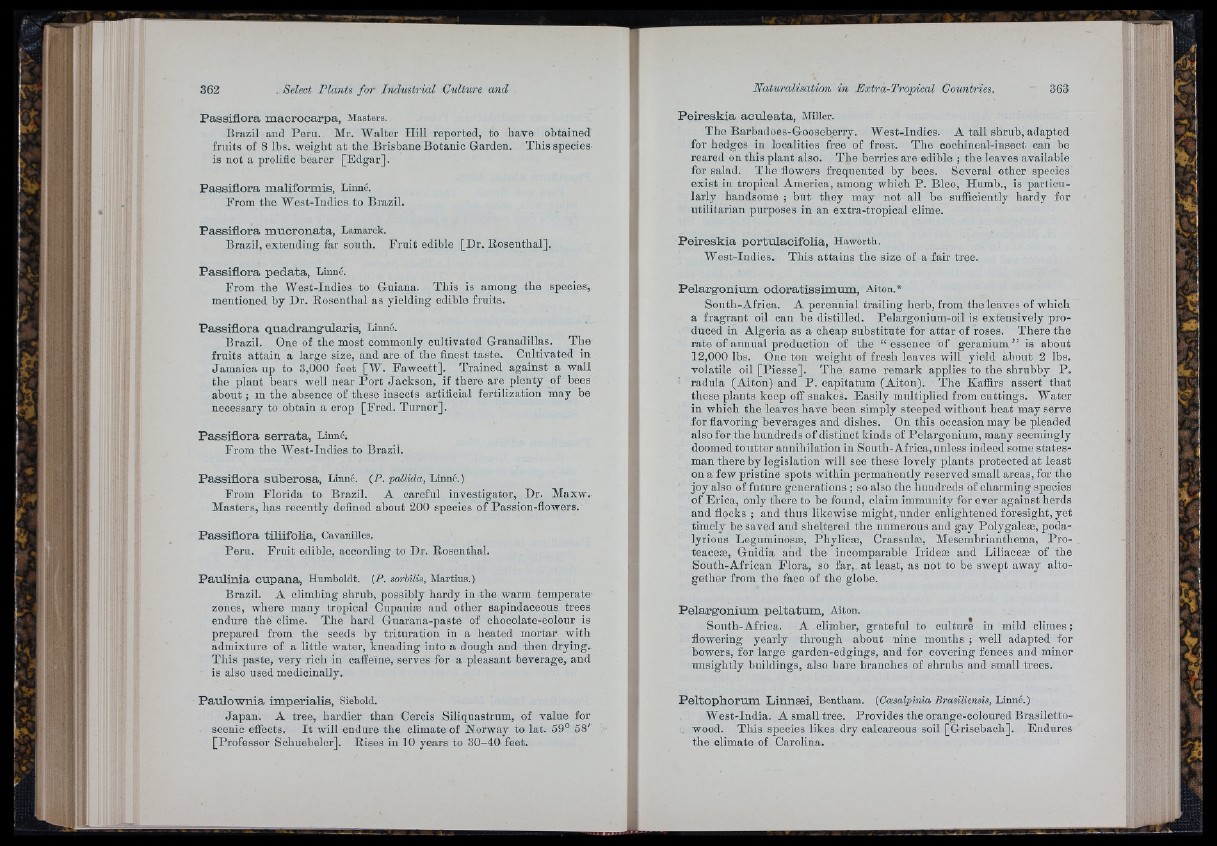
Passiflora macrocarpa, Masters.
Brazil and Peru. Mr. Walter Hill reported, to have obtained
frnits of 8 lbs. weight a t the Brisbane Botanic Garden. This species
is not a prolific bearer [Edgar].
Passiflora maliformis, Linné.
From the West-Indies to Brazil.
Passiflora mucronata, Lamarck.
Brazil, extending far south. F ru it edible [Dr. Rosenthal].
Passiflora pedata, Linné.
From the West-Indies to Guiana. This is among
mentioned by Dr. Rosenthal as yielding edible fruits.
the species,
Passiflora quadrangularis, Linné.
Brazil. One of the most commonly cultivated Granadillas. The
fruits attain a large size, and are of the finest taste. Cultivated iu
Jamaica up to 3,000 feet [W. Fawcett]. Trained against a wall
the plant bears well near Port Jackson, if there are plenty of bees
about ; in the absence of these insects artificial fertilization may be
necessary to obtain a crop [Fred. Turner].
Passiflora serrata, Lhmc.
From the West-Indies to Brazil.
Passiflora suberosa, Linné. (P . pallida, Linné. )
From Florida to Brazil. A careful investigator, Dr. Maxw.
Masters, has recently defined about 200 species of Passion-flowers.
Passiflora tiliifolia, Cavanilles.
Peru. F ru it edible, according to Dr. Rosenthal.
Paulinia cupana, Humboldt. (P . sorhilis, Martins.)
Brazil. A climbing shrub, possibly hardy in the warm temperate
zones, where many tropical Cupaniæ and other sapindaceous trees
endure the clime. The hard Guarana-paste of chocolate-colour is
prepared from the seeds by trituration in a heated mortar with
admixture of a little water, kneading into a dough and then drying.
This paste, very rich in caffeine, serves for a pleasant beverage, and
is also used medicinally.
Paulownia imperialis, Siebold.
Japan. A tree, hardier than Cercis Siliquastrum, of value for
scenic effects. I t will endure the climate of Norway to lat. 69° 58'
[Professor Schuebeler]. Rises in 10 years to 30-40 feet.
I
Poireskia aculeata, Miller.
Tho Barbadoes-Gooseberry. West-Indies. A tall shrub, adapted
for hedges in localities free of frost. The cochineal-insect can be
reared on this plant also. The berries are edible ; the leaves available
for salad. The flowers frequented by bees. Several other species
exist in tropical America, among which P. Bleo, Hiimb., is parlicu-
larly handsome ; bnt tliey may not all be sufficiently hardy for
utilitarian purposes in an extra-tropical clime.
Peireskia portulacifolia, Haworth.
West-Iudies. This attains the size of a fair tree.
Pelargonium odoratissimum, Aiton.*
South-Africa. A perennial trailing herb, from the leaves of which
a fragrant oil can he distilled. Pelargonium-oil is extensively produced
in Algeria as a cheap substitute for a tta r of roses. There the
rate of annual production of the “ essence of geranium ” is about
12,000 lbs. One ton weight of fresh leaves will yield about 2 lbs.
volatile oil [Piesse]. The same remark applies to the shrubby P .
■ radula (Aiton) and P . capitatum (Aiton). 'Phe Kaffirs assert that
these plants keep off snakes. Easily multiplied from cuttings. Water
in which the leaves have been simply steeped w ithout heat may serve
for flavoring beverages and dishes. On this occasion may be pleaded
also for the hundreds of distinct kinds of Pelargonium, many seemingly
doomed to u tter annihilation in South-Africa, unless indeed some statesman
there by legislation will see these lovely plants protected at least
on a few pristine spots within permanently reserved small areas, for the
joy also of future generations ; so also the huudreds of charming species
of Erica, only there to be found, claim immunity for ever against herds
and flocks ; and thus likewise might, under enlightened foresiglit, yet
timely be saved and sheltered the numerous and gay Polygaleæ, poda-
lyrious Leguminosæ, Phylicæ, Crassulæ, Mesemhrianthema, Pro-
teaoeæ, Gnidia and the incomparable Irideæ and Liliaceæ of the
South-African Flora, so far, at least, as not to be swept away altogether
from the face of the globe.
Pelargonium peltatum, Aiton.
South-Africa. A climber, grateful to culture in mild climes ;
flowering yearly through about nine months ; well adapted for
bowers, for large garden-edgings, and for covering fences and minor
unsightly buildings, also bare branches of shrubs and small trees.
Peltophorum Linneei, Bentham. (Ocesalpinia Brasiliensis, Linnc.)
West-India. A small tree. Provides the orange-coloured Brasiletto-
wood. This species likes dry calcareous soil [Grisebach]. Endures
the climate of Carolina.
' ! : i.fr!''
. ' 1 ,
‘
' P ■ ; i